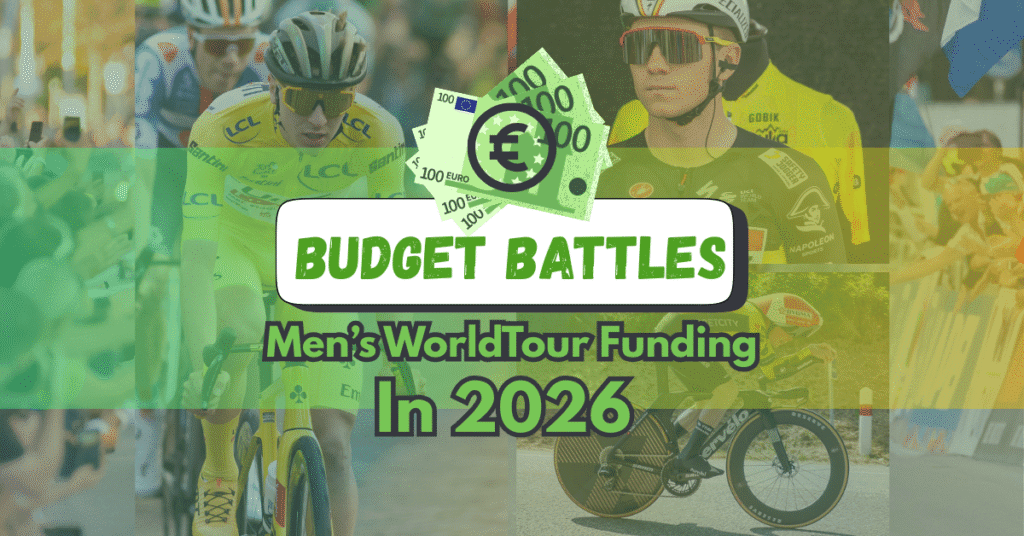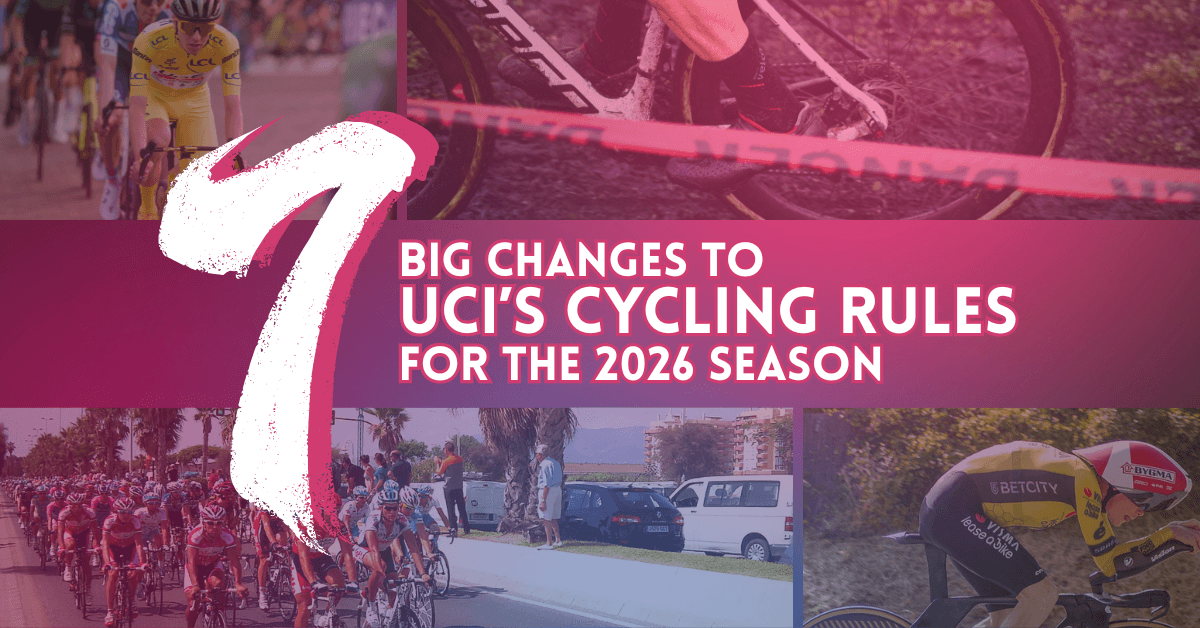While Jonas Vingegaard stamps on his competition at the Vuelta a España, another fight is going on behind the scenes… and these battles have a financial twist. Which teams will see the biggest budgets for 2026? As superteams come and go, let’s take a deep dive into which bags of money the top riders and squads can draw from, and how those might change in the coming years.

The financial side of cycling.
Cycling is a growing sport from a financial perspective. According to Gazzetta dello Sport and Domestique Cycling reports, the total amount of funding for all men’s WorldTour teams has increased each year. In fact, moving from €379 million combined budget in 2021 to over €570 million for 2025 represents almost 50% of growth over the past four years. The increases are also striking for the women’s WorldTour: they’ve gone from €33 million in 2022 to €70 million in 2025, more than doubling the total budget over the past three years.
Where does the money come from? Unlike in other sports such as football, cycling has limited opportunities to commercialize ticket sales or events for income. Instead, 87% of all funding comes from sponsors who pay for brand visibility and access to the sport’s stars for their advertisements.
Read more: Sponsors, Points, and Pressure: High Stakes at the Tour de France
At the individual team level, the average budget hovers around €32 million, with a median of €27 million. But with big gaps between the top teams, or superteams, and the rest of the pack, the amount of money available can still vary significantly by each squad.
Why do teams need such big incomes?
Cycling is an expensive sport… and it’s not quite like the sticker shock you might have felt the last time you looked at the top-end choices in your favorite local bike shop.
Instead, salaries for high-performing riders consumes a big chunk of each team’s budget each year. Additionally, they must consider salaries for other team staff, like sports directors, mechanics, physios and other support staff members.
What about the equipment? The bikes the pros use are top of the line, but they also need other gear, like kit, helmets, shoes, and sunglasses, that are all very high-quality as well. Some of the costs of these items are defrayed through sponsorship, and brands that provide their product to pro teams are guaranteed a lot of visibility and free advertising. However, other expensive necessities, like team cars and buses or mechanics equipment, are less flashy.
Travel and logistics budgeting is also somewhat underrated but critically important for pro teams. Flights, hotels, and day-to-day expenses for the riders add up. A team must carefully budget for training camps as well as each race on the calendar to be sure that their riders and staff can get from point A to B with minimal expense.
Embed from Getty ImagesWhich men’s teams will have the most money in 2026?
The finances of cycling can be unpredictable. A big sponsor can bring in big funding for a previously unremarkable team… if they can secure it. But what trends from the past several years show which teams are growing and which are on the decline? Let’s check out some predictions for the top teams in 2026 based on their expected budgets for 2023-2025. Stats come from ProCyclingUK for 2023 and 2024, as well as The Cycling Sonar for 2025.
Across the board, UAE Team Emirates remain at the top of the budget battle over the past three years. Their consistent budget of around €60 million comes primarily from their backers from United Arab Emirates, support that has garnered some criticism over the years. The budget for UAE Team Emirates is likely to stay around €60 million for 2026.
Another top team is Visma Lease-a-Bike, now fully recovered from their sponsor shuffle in years past. Despite wins at the WorldTour level, this superteam has seen a slight budget drop with the departure of their former primary title sponsor, Jumbo. However, they still held onto to around €45 million to work with in 2025, and now they also are rebuilding a relationship with their past sponsor Rabobank… which could see a minor increase for them. For 2026, Visma Lease-a-Bike will likely command a budget of around €50 million.
The new kids on the superteam block are Red Bull Bora Hansgrohe. A big investment from Red Bull catapulted this squad into the top teams, starting with a respectable €25-30 million in 2023 up to a whopper €50 million in 2025. This accelerated growth has led to some big signings for the team (hello, Remco Evenepoel?), as well as some impressive victories such as Florian Lipowitz’s Tour de France podium. As such, Red Bull Bora Hansgrohe’s total budget will probably grow to over €55 million in 2026, assuming that Red Bull’s funding or interest isn’t running dry just yet.
Embed from Getty ImagesSuperteams… and superteam wannabes.
Just below the top-tier superteams, a lot of teams are fighting to raise their profile… and more money. INEOS Grenadiers, which held onto a top-tier budget of up to €55 million in 2023, has fallen to just around €40 million for 2025. Unlike Visma Lease-a-Bike, the team’s results have also been on the decline, meaning that we may see them fall further in the budget rankings. Similarly, Soudal Quick-Step has held steady with around €30 million over the past three years, but their loss of Evenepoel shows that they’ll need a big more cash in hand if they want to play with the big dogs.
It’s not all doom and gloom, however. Decathlon recently announced that they’ll have a budget of €40 million in 2026 despite the loss of longterm sponsor AG2R La Mondiale. It’s a nice improvement for the team that puts them in financial striking distance of big teams like Visma… if they can bring the results to back up the bucks.
The bottom of the barrel.
On the other hand, a lot of teams are struggling… more often than not, due to the need for well-paying title sponsors. According to Cycling Weekly, 15 of the men’s WorldTour teams are currently looking for new title sponsors. That’s a big chunk of the peloton potentially looking at losses of funding for 2026.
Which teams need the most help? Alpecin-Deceunick, the team which feels like a superteam due to being built around a superstar Mathieu van der Poel, will need to replace Deceunick for 2026. Quick-Step may also be leaving Soudal Quick-Step. Some of these big names have been part of the pro sport for a long time.
What happens when the money doesn’t come through? For Arkea-B&B Hotels, it means an end to the team altogether — the squad likely won’t be returning to the 2026 peloton. Sometimes other options are possible: for example, Intermarché-Wanty and Lotto will merge into a combined team to pool resources for next year. But this creates more problems for the riders and staff who won’t be retained, and some may struggle to find new positions or contracts for 2026 as well.
All of these situations point to cycling’s lack of stability when it comes to funding. Even when things are growing, it’s not always consistent for all teams.
Quiz: How Well Do You Know Team Jerseys Past and Present?
Is modern pro cycling financially sustainable?
The problems with holding onto a title sponsor go to show that sometimes stability is more important than big money. If so many teams are going through sponsor changes, does it mean that cycling’s money isn’t really growing as much as we think?
In reality, a lot of the new funding for cycling is consolidated in a few teams. Superteams suck up most of the budget, leaving smaller teams in trouble. But despite that, there’s still space for new sponsors to come in. The example of Red Bull’s entry into the sport, along with the big results for Lipowitz and others throughout the season, are a nice example for other brands thinking of entering the world of cycling sponsorship. Some big names have already come in over the past few years, like Lidl and Decathlon. More may follow.
Part of the reason cycling is still appealing to sponsors is the perception that the doping problem is cleared up from years past. But now cycling faces a new ethical dilemma: sportswashing. Countries like UAE, Bahrain, or Astana may have deep pockets, but is it worth it? The new OneCycling idea backed by Visma Lease-a-Bike’s Richard Plugge among others is funded by Saudi Arabian sources, which is questionable to say the least.
As a sport, cycling needs to put limits on how teams are funded to prevent these ethical problems from taking shape, and stop the sport from becoming even more of a vehicle for image rehabilitation. Many teams, even Tour de France winning superteams like VLAB, are still sponsored by private companies, but will that change in the future?
Embed from Getty ImagesPlacing a limit on growth.
In 2024, the UCI started talking about placing a budget cap on cycling teams. Now, it looks like that might happen as soon as 2026, or at least be on the table for the future.
But does it help? Sure, an overall cap may curtail the super big teams like UAE or VLAB from growing any bigger. However, it won’t confront the other issues with sponsorship mentioned above — or stop something like OneCycling from plowing through and changing the ways we can enjoy cycling as fans or spectators.
From my perspective, the UCI should think less about the overall money inequalities and more about where the money is coming from. State-sponsored teams will continue to dominate the sport as long as they can get all the resources they need from their rich backers, and a UCI cap isn’t likely to change all the ways the money can come in. If a budget cap is introduced in the coming years, we may see more sponsorship of individual riders within a team as a way to circumvent the regulations.
Whatever the case, the end goal for these entities going after sportswashing will remain attainable. And that’s the current biggest problem with the money coming into the sport.
Closing thoughts.
For 2026, we’ll see much of the same for the financial side of cycling: superteams dominate the budget battles while smaller teams might have a harder time staying afloat. But underneath the surface, it’s more about where the money comes from than the dollar amount.
As more private sponsors and big companies come into cycling, we can only hope that successful teams like Lidl-Trek or Red Bull Bora Hansgrohe eventually edge out the state sponsors. And it’s fantastic to see these big names entering the ring. Which teams are positioned to become the next superteams? The Decathlon budget for 2026 shows that there’s really no guessing until it’s a done deal. Each and every team has a chance at a bigger budget in the future… and that can mean bigger results in races, too.
In cycling, the old adage really holds true: money makes the world go ‘round!
Embed from Getty ImagesWhich team do you hope would get a budget bump for 2026? Are our predictions spot-on or way off-base? Let us know your thoughts in the comments or on social media! ★










Leave a Reply